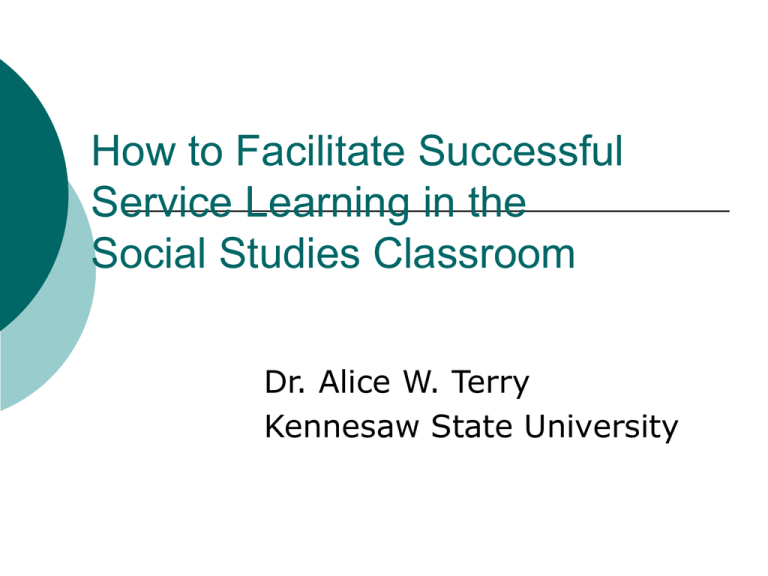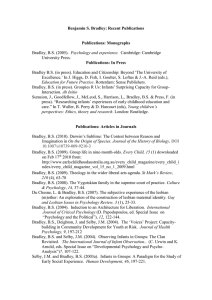Service-Learning for the Social Studies Classroom
advertisement

How to Facilitate Successful Service Learning in the Social Studies Classroom Dr. Alice W. Terry Kennesaw State University Garfield on Community Service What is Service Learning? What is Service-Learning? “...an innovative teaching methodology that integrates community service with academic study to enrich learning, teach civic responsibility and strengthen communities. ” National Commission on S ervice-Learning, 2002 . The power of service-learning for American schools “Service-Learning is a particularly fertile way of involving young people in community service, because it ties helping others to what they are learning in the classroom. In the process, it provides a compelling answer to the perennial question: ‘Why do I need to learn this stuff?’” General Colin Powell, founding chairman of America ’s Promise A recent report from the Center for Information and Research on Civic Learning and Engagement (CIRCLE) found that: 57% of 15 to 25-year-olds are completely disengaged from civic life. 1) Preparation 2) Action 3) Reflection 4) Celebration/Demonstration Preparation What will you do? Who will you need to help you? How will you make contacts? How will you begin? How will you incorporate this experiential design into your content curriculum? How will you incorporate this experiential design into your classroom? JUST DO IT!! …the process of gaining meaning and understanding from experience …helps students identify their own values, develop empathy for others, and compare their assumptions to real world experience …the key to successful experienced-based programs Celebration... Multiple methods designed to acknowledge, recognize and further validate student’s service work (Toole, Conrad & Nelson, 1998) In order to gain the most from their service experience, students need exposure to the 3 R’s of Celebration: Recognition, Respect, and Reward. (Bohnenberger and Terry, 2002) The K-12 Developmental Service Learning Typology …addresses the differences in service learning activities based on the level of student learning and service. Community Service level… Students Volunteer as a docent at an historical museum in your community Bradley’s Level 1 corresponds to Bradley’s Community Service: Reflection is informal students observe without giving insights into the reasons behind the observation Task is one dimensional Observation reflections are conventional or repetitions of what students have heard from others Community Exploration level… Students Research your town history. Investigate and write a report on historical buildings, sculptures, or activities in your community Bradley’s Level 2 corresponds to Bradley’s Community Exploration: Reflections are more thorough But do not allude to broader system in which the aspect is embedded Analysis Students demonstrate a beginning ability to interpret evidence Community Action level… Students Brainstorm ways to publicize and/or preserve your community's heritage. Then design and implement a plan of action to increase interest in your town and tourism Students identify a need area, develop a plan, take Action..... ...and get RESULTS!! Bradley’s Level 3 corresponds to Bradley’s Synthesis Community Action: Students view things from multiple perspectives make appropriate judgments based on reasoning and evidence perceive conflicting goals within the situation recognize that the differences can be assessed How can you integrate service learning into the curriculum? Will it be part of an elective class or a content class? Will it be tied to the content and/or skill objectives? Can it help meet school objectives? Can it be continued throughout the semester or year? Choice and Voice in Service Learning Give the students a choice and voice in deciding the focus for the activity This insures more interest in and commitment to the activity Choice and Voice •Let students select the project •Allow students to conduct their own research around their interests •Design working groups based on different intelligences and interests, i.e, Media Facilitators Public Relations Art Technology Communications Using Choice and Voice in Reflection Giving students a voice in how they relate their reflections can lead to higher levels of reflection. Journaling Writing poetry Singing a song they wrote Role-playing Creating a slide show How can I find the time? Try an interdisciplinary approach Compact the curriculum/differentiation effective when the same service learning theme is explored in multiple classes Cover required curriculum in 4 days in a week; use the 5th day for service learning, etc. Reschedule the school day so that a block of time is available for service learning Decide on the type of service… Students take positive hands-on action to make a difference in the community through needed projects identified, organized, and implemented by the students Students engage in social action and advocacy designed to impact decision-making on public issues by raising awareness, getting bills passed, etc. Students assist and support an existing, established effort such as the Cancer Society, Kidney Foundation, MADD, Meals-on-Wheels, Save the Rain Forest, etc. Cooperative Learning Strategies Cooperative Groups and Jobs Project Facilitators - elected Press Secretaries Video Coordinators Photographers File Clerks Journalists Scrapbook Coordinators Cognitive Apprenticeship Model (Brown, Collins, & Duguid, 1989) Four elements that lead to learning: Scaffolding Modeling Coaching Fading Teacher’s role: facilitator Student-run, student-focused class Creative Problem Solving Process (Osborn, 1963; Parnes, 1967) Identifying problems & challenges Recognizing and stating the important problem Producing alternative solutions Evaluating alternative solutions Planning to put solutions into use (Torrance, Brainstorms anyone? Have students brainstorm possible problems on a Jot Board problems discovered during fact-finding problems the students may encounter while trying to effect change in the community. Narrow the brainstormed challenge ideas to five or six. From among this list, select an Underlying Challenge by identifying the most significant issue—the problem on which that the class feels it can have the most impact and influence. Students work together as ideas flourish on the Jot Board! Tips & Techniques What’s in a name? A group identity and unity is often established within a group or class by encouraging the service learning students to choose an acronym, a name, for the group and/or the project RIPPLES, SWaMP Kids, Backstage Crew Tips & Techniques •A team T-shirt is fun for the students to create •It can unify the students as well as advertise the service learning project •The T-shirt can be worn on any project outing or presentation •The design should be connected to the project topic and/or the project goals Tips & Techniques for Community Meetings Students get the group on the agenda of the meeting—call at least a week in advance Select a spokesperson to represent the class Prepare a complete, concise, and creative presentation The spokesperson presents the ideas your class has with others providing support • * Create and Implement Plan of Action Fly!* Generate and Evaluate Action Ideas Generate Challenges and Select Underlying Challenge Conduct Extensive Research Identify Areas of Concern in the Community Perhaps the old African proverb, “It takes a village to raise a child, ” will coexist with a new American proverb, “It takes a child to raise up a village. ” (Te rry, 2000) www.Heinemann.com


